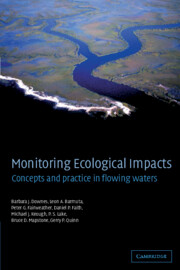Book contents
- Frontmatter
- Contents
- Preface and Acknowledgements
- Part I Introduction to the nature of monitoring problems and to rivers
- Part II Principles of inference and design
- 4 Inferential issues for monitoring
- 5 The logical bases of monitoring design
- 6 Problems in applying designs
- 7 Alternative models for impact assessment
- Part III Applying principles of inference and design
- References
- Index
7 - Alternative models for impact assessment
Published online by Cambridge University Press: 21 August 2009
- Frontmatter
- Contents
- Preface and Acknowledgements
- Part I Introduction to the nature of monitoring problems and to rivers
- Part II Principles of inference and design
- 4 Inferential issues for monitoring
- 5 The logical bases of monitoring design
- 6 Problems in applying designs
- 7 Alternative models for impact assessment
- Part III Applying principles of inference and design
- References
- Index
Summary
In chapter 5, we developed a logical framework for assessing impacts, including the necessity for control or reference areas, and for sampling to occur before and after the putative impact. In this chapter, we consider practical details of the monitoring, focusing on the formal design and statistical analysis appropriate to the detection of impacts, and on the practical details associated with executing these designs in running waters. It is important to realize that we can only translate general design principles into a specific plan to collect data if we specify the statistical model that is to be fitted to the data. Perhaps the most important message of this chapter is that apparently similar monitoring ‘questions’ can have quite different statistical models behind them. These different models, in turn, can lead to quite different advice about how to optimize a particular data collection program.
If we consider the two major tasks outlined earlier, the formal test for the existence of an unacceptable impact and the characterization of the spatial extent of any impact, the latter procedure is relatively straightforward in terms of the design and underlying statistical models. The detailed design is modified by practical considerations associated with stream environments, and the characteristics of the activity suspected of having an impact.
In contrast, there is a range of design options for detecting an impact.
- Type
- Chapter
- Information
- Monitoring Ecological ImpactsConcepts and Practice in Flowing Waters, pp. 164 - 194Publisher: Cambridge University PressPrint publication year: 2002



